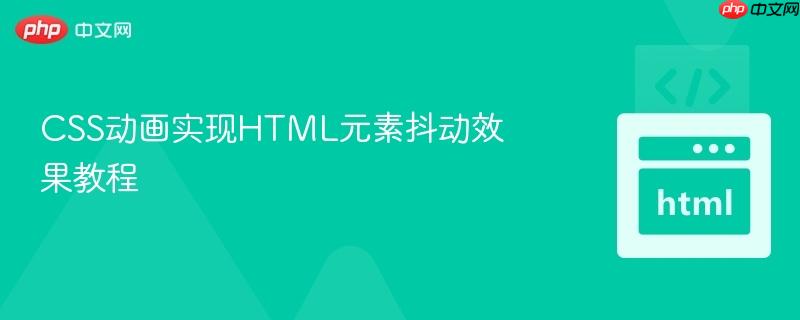
本教程详细介绍了如何利用css的`@keyframes`和`animation`属性为html元素创建逼真的抖动效果。文章不仅涵盖了抖动动画的css定义、持续时间、重复次数等控制方法,更深入探讨了如何通过javascript动态添加/移除css类,实现“函数式”按需触发抖动效果,并提供了完整的代码示例和最佳实践建议。
理解CSS动画与抖动效果
在网页开发中,CSS动画是实现各种动态视觉效果的强大工具。抖动效果(Shake Animation)通过快速、小幅度的位移和旋转,模拟物体受到冲击或震动时的状态。要实现这种效果,我们主要依赖CSS的@keyframes规则来定义动画的各个阶段,以及animation属性来控制动画的播放方式。
核心原理:CSS @keyframes 定义抖动
@keyframes规则允许我们定义动画在不同时间点的样式。对于抖动效果,我们会在动画的0%到100%之间,通过transform属性不断改变元素的translate(位移)和rotate(旋转)值,从而营造出不规则的晃动感。
以下是一个经典的抖动@keyframes定义:
@keyframes shake {
0% { transform: translate(1px, 1px) rotate(0deg); }
10% { transform: translate(-1px, -2px) rotate(-1deg); }
20% { transform: translate(-3px, 0px) rotate(1deg); }
30% { transform: translate(3px, 2px) rotate(0deg); }
40% { transform: translate(1px, -1px) rotate(1deg); }
50% { transform: translate(-1px, 2px) rotate(-1deg); }
60% { transform: translate(-3px, 1px) rotate(0deg); }
70% { transform: translate(3px, 1px) rotate(-1deg); }
80% { transform: translate(-1px, -1px) rotate(1deg); }
90% { transform: translate(1px, 2px) rotate(0deg); }
100% { transform: translate(1px, -2px) rotate(-1deg); }
}在这个@keyframes中:
立即学习“前端免费学习笔记(深入)”;
- 0%到100%代表动画的整个时间线。
- transform: translate(x, y)用于使元素在水平和垂直方向上进行小幅度的位移。
- transform: rotate(deg)用于使元素进行小幅度的旋转。 通过组合这些微小的、不规则的变化,即可形成视觉上的抖动效果。
应用动画到HTML元素
定义好@keyframes后,我们需要使用animation属性将其应用到目标HTML元素上。animation是一个简写属性,可以同时设置多个动画相关的子属性,包括:
- animation-name: 指定要播放的@keyframes名称(例如shake)。
- animation-duration: 动画持续时间(例如0.5s表示0.5秒)。
- animation-timing-function: 动画的缓动函数(例如ease-in-out)。
- animation-delay: 动画开始前的延迟时间。
- animation-iteration-count: 动画播放次数(例如infinite无限次,或具体数字)。
- animation-direction: 动画是否应该轮流反向播放。
- animation-fill-mode: 动画结束后或开始前的状态。
基础示例:持续抖动
为了演示抖动效果,我们可以创建一个简单的div元素,并为其添加样式。
HTML元素抖动效果 我正在抖动!
动态触发抖动效果(“函数式调用”)
在实际应用中,我们通常需要根据用户的交互或其他事件来触发抖动,而不是让它一直抖动。这类似于“调用一个函数”来执行抖动。实现这一目标最常用的方法是结合JavaScript和CSS类。
步骤1:定义一个包含动画的CSS类
首先,创建一个CSS类(例如is-shaking),它只在需要抖动时才被应用。我们将动画的持续时间设置为3秒,并只播放一次。
/* ... (之前的 @keyframes shake 保持不变) ... */
.is-shaking {
animation: shake 0.1s ease-in-out 0s 30; /* 0.1s 持续时间,重复30次 = 3秒 */
/* 或者更精确地控制总时长,例如 */
/* animation: shake 3s forwards; */ /* 3秒总时长,动画结束后停留在最终状态 */
}注意:
- animation: shake 0.1s ease-in-out 0s 30; 意味着每次抖动周期是0.1秒,重复30次,总共持续3秒。
- animation: shake 3s forwards; 意味着整个抖动动画持续3秒,并且forwards会使元素在动画结束后保持最后一帧的样式。选择哪种方式取决于你希望抖动是快速重复还是平滑过渡。为了更接近真实的“抖动”,通常选择快速重复小周期。
步骤2:使用JavaScript动态添加/移除CSS类
接下来,我们使用JavaScript来控制这个is-shaking类的添加和移除。
动态触发HTML元素抖动 点击按钮抖动我
在上述JavaScript代码中:
- 我们获取了目标div元素和触发按钮。
- 为按钮添加了一个点击事件监听器。
- 当按钮被点击时,我们首先检查myDiv是否已经包含is-shaking类,以防止动画在进行中被重复触发。
- 如果不在抖动,就通过myDiv.classList.add('is-shaking')添加该类,从而启动CSS动画。
- 使用setTimeout函数,在shakeDuration(3000毫秒,即3秒)后,通过myDiv.classList.remove('is-shaking')移除该类,停止抖动动画。
抖动整个窗口
如果需要让整个HTML窗口(或页面内容)抖动,可以将is-shaking类应用到body元素或一个包裹了所有页面内容的顶级div上。例如:
/* CSS */
#page-wrapper {
/* 确保它占据整个视口 */
min-height: 100vh;
width: 100vw;
/* 其他样式 */
}
#page-wrapper.is-shaking {
animation: shake 0.1s ease-in-out 0s 30;
}// JavaScript
const pageWrapper = document.getElementById('page-wrapper');
// ... 像上面一样控制 pageWrapper 的 class注意事项与最佳实践
- 性能优化: 在CSS动画中,使用transform属性(如translate、rotate、scale)通常比改变top、left、margin等属性具有更好的性能,因为它能利用GPU加速。本教程的抖动效果正是基于transform。
- 用户体验: 抖动效果可能会对某些用户造成不适,特别是那些对运动敏感或有前庭系统障碍的用户。应谨慎使用,并考虑提供关闭动画的选项,或者仅在特定、非关键的交互中使用。
- 动画时长与频率: 抖动效果不宜过长或过于频繁。3秒是一个相对合理的持续时间。过长的抖动会分散用户注意力,甚至引起烦躁。
- 目标选择: 确定抖动的目标是特定元素、容器还是整个页面。对整个页面进行抖动应特别小心,因为它会影响所有内容的可读性。
- 浏览器兼容性: 现代浏览器对CSS @keyframes和animation的支持非常好,但在非常老的浏览器中可能需要添加浏览器前缀(如-webkit-),不过现在已不常见。
总结
通过本教程,我们学习了如何利用CSS的@keyframes定义复杂的抖动动画,并使用animation属性将其应用到HTML元素。更重要的是,我们掌握了如何结合JavaScript,通过动态添加和移除CSS类的方式,实现按需、可控地触发抖动效果,这使得动画在用户交互中变得更加灵活和实用。在实际开发中,请务必权衡动画的视觉效果与用户体验,确保其能为产品增色而非造成干扰。































